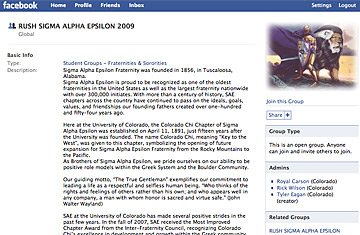
In 2004, after two University of Colorado coeds died from alcohol poisoning in fraternity houses in Boulder, the university demanded tighter control over Greek organizations, including forcing them to delay recruiting until freshmen entered their second semester. The sororities agreed to the reforms, but all 15 fraternities balked — and moved off campus. Marc Stine, a Greek advocate hired by CU's Alumni Interfraternity Council, says it was a little like a rebellious son leaving home. "As he drives away, the parent stands at the door shaking his fist and yelling, 'You'll never make it out there.'" (See pictures of the college dorm's evolution.)
And the administrators were right, at least initially. Membership fell once the fraternities were no longer listed in CU directories and the school stopped handing over free address lists of incoming freshmen. At the Sigma Alpha Epsilon house, membership dropped to 24 members in 2005. "No one saw the half-page ad the fraternities placed in the college newspaper," says Stine. "That's where Facebook, MySpace and e-mail entered the picture."
"When we put on events like philanthropic seminars, we'll usually put up a Facebook page and either invite specific people that we're recruiting or the general freshman class," says Royal Carson, president of CU's SAE chapter. (How do the fraternities gather contact info for incoming freshmen? By Facebook stalking, of course. Most students belong to organizations or networking groups that have Facebook pages.) "It's a way for incoming freshmen to see that the Greek system is not what it's perceived to be, not just a place to party. We do other functions. Our real mission is trying to better ourselves and make lifelong friends rather than party 24/7." (See the best social networking applications.)
Today, SAE has 92 members, including this year's 38 pledges, all of whom registered on the group's Facebook page. SAE's Carson, a 20-year-old sophomore from Dallas, says of recruiting new members: "It all starts with some sort of introduction, and that's where I credit Facebook, making that first introduction, being the icebreaker." Overall, fraternity memberships at CU are up 65% since the organizations moved off campus in 2005. "We just finished a huge rush last fall," Stine says. And came in under budget, too. "When we did the post-market analysis and asked, 'How did you find out about the fraternities?,' overwhelmingly, kids said 'the Internet.'"
Fraternities still rely on low-tech means to raise awareness of Greek life. One weekend in February, 100 fraternity members used chalk to blanket campus sidewalks with the interfraternity council's web address. But Pete Smithhisler, who is president and CEO of North-American Interfraternity Conference, says nearly every Greek organization in the nation now has an online presence. And these groups are using as many technological outlets as possible to improve the bonds of brother- and sisterhood. "You remember how, when we were in college, going to the dining hall, you had to search, there was always that moment of trepidation of who you were going to sit with?," he says. "Today they use Twitter: 'I'm going to lunch. Who's going to join me?'"
See pictures of college mascots.
